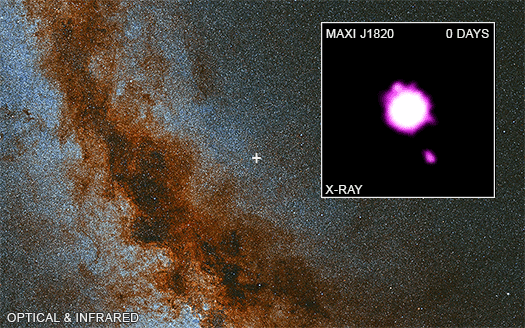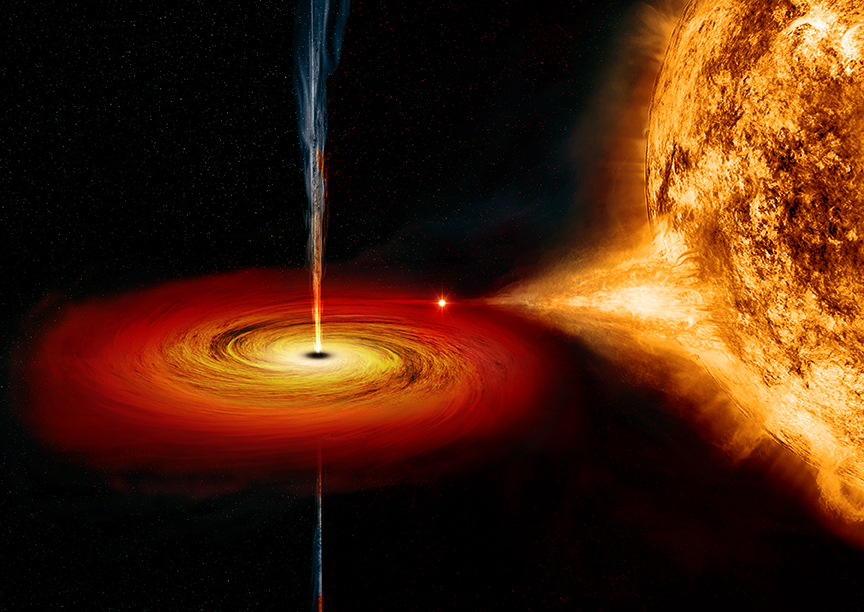Black hole caught spewing jets into space at nearly the speed of light (video)
A black hole shooting out gassy material at nearly the speed of light has been caught on video by a space telescope.
NASA's Chandra X-ray Observatory saw an outburst from the black hole and its companion star, which are part of a binary system called MAXI J1820+070. The system is 10,000 light-years from Earth, which is relatively close to our planet in the cosmic scheme of things and allows for a detailed investigation.
As the companion star, which is about half the mass of the sun, whirls around the black hole, the strong gravity of the stellar-mass black hole — roughly eight times the mass of the sun — nabs material from the star into an accretion disk, producing a glowing sphere of gas that emits bright X-rays. Some of the gas falls back into the black hole, but some of it gets blasted away from the black hole in a pair of jets that point in opposite directions.
Video: Black Hole outburst seen by X-ray observatory
Related: The strangest black holes in the universe

This outburst was one of the highest-speed explosions from stellar-mass black holes ever observed in X-rays, with about 400 million billion pounds (181 million billion kilograms) of material thrown out of the black hole in two jets that sprung up in July 2018.
"This amount of mass is comparable to what could be accumulated on the disk around the black hole in the space of a few hours, and is equivalent to about a thousand Halley's Comets or about 500 million times the mass of the Empire State Building," NASA said in a statement.
Footage of the black hole's activity was captured by Chandra in four sets of observations taken in November 2018, and three times in 2019 (February, May and June). The jets appear, from Earth's perspective, to be moving at incredible speeds due to an optical illusion.
Get the Space.com Newsletter
Breaking space news, the latest updates on rocket launches, skywatching events and more!
At first glance, the northern jet appears to be spewing out material at 60% the speed of light, while the southern jet appears to be moving at an impossible 160% the speed of light. NASA said this is due to a phenomenon known as "superluminal motion." The phenomenon, NASA explained, happens "when something travels towards us near the speed of light, along a direction close to our line of sight."
"This means," the agency continued, "[that] the object travels almost as quickly towards us as the light it generates, giving the illusion that the jet's motion is more rapid than the speed of light. In the case of MAXI J1820+070, the southern jet is pointing towards us and the northern jet is pointing away from us, so the southern jet appears to be moving faster than the northern one. The actual velocity of the particles in both jets is greater than 80% of the speed of light."
Observations of binary systems containing a black hole and a companion star, such as MAXI J1820+070, could provide more information about how jets are formed and how the jets interact with their surroundings, NASA said.

The black hole's activity has also been observed in radio wavelengths, by a team led by Joe Bright from the University of Oxford in England. Bright's team also reported the superluminal motion, based on the radio data alone, NASA said. Chandra's contribution to this previous research was doubling the length of time astronomers could track the jets, and also providing more data about the jets in X-ray observations — such as the fact that particles in the jets decelerate as they move away from the black hole.
"Most of the energy in the jets is not converted into radiation, but is instead released when particles in the jets interact with surrounding material," NASA said. "These interactions might be the cause of the jets' deceleration. When the jets collide with surrounding material in interstellar space, shock waves — akin to the sonic booms caused by supersonic aircraft — occur. This process generates particle energies that are higher than that of the Large Hadron Collider."
A paper based on the research was published in Astrophysical Journal Letters. The research was led by Mathilde Espinasse, who has affiliations at the University of Paris-Saclay, the University of Paris Diderot and the University of Paris.
- 'Light echoes' of black hole reveal clues behind dazzling x-ray flares
- Jets blast out of famous black hole at 99% the speed of light
- This black hole's jets wobble like crazy because it's warping space-time
Follow Elizabeth Howell on Twitter @howellspace. Follow us on Twitter @Spacedotcom and on Facebook.
OFFER: Save 45% on 'All About Space' 'How it Works' and 'All About History'!
For a limited time, you can take out a digital subscription to any of our best-selling science magazines for just $2.38 per month, or 45% off the standard price for the first three months.
Join our Space Forums to keep talking space on the latest missions, night sky and more! And if you have a news tip, correction or comment, let us know at: community@space.com.

Elizabeth Howell (she/her), Ph.D., was a staff writer in the spaceflight channel between 2022 and 2024 specializing in Canadian space news. She was contributing writer for Space.com for 10 years from 2012 to 2024. Elizabeth's reporting includes multiple exclusives with the White House, leading world coverage about a lost-and-found space tomato on the International Space Station, witnessing five human spaceflight launches on two continents, flying parabolic, working inside a spacesuit, and participating in a simulated Mars mission. Her latest book, "Why Am I Taller?" (ECW Press, 2022) is co-written with astronaut Dave Williams.










